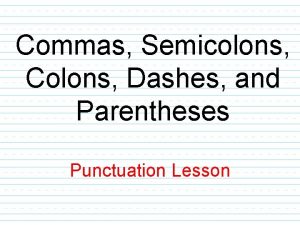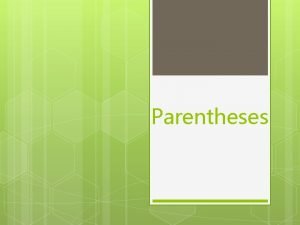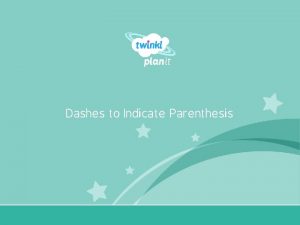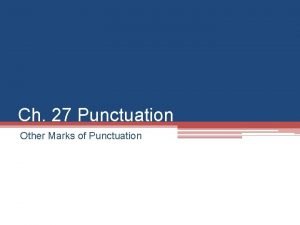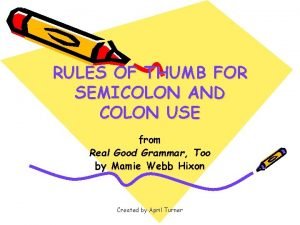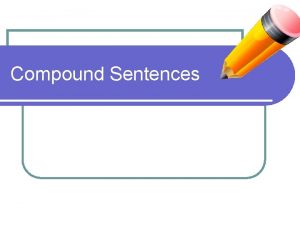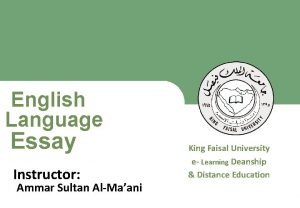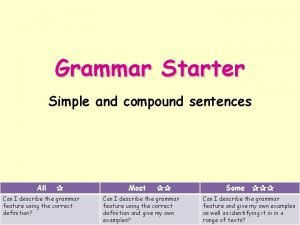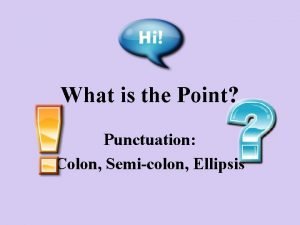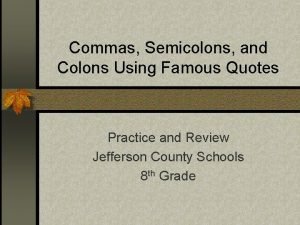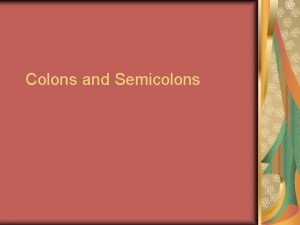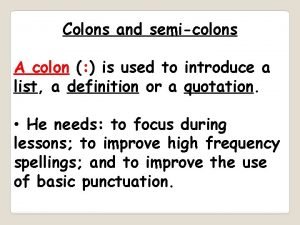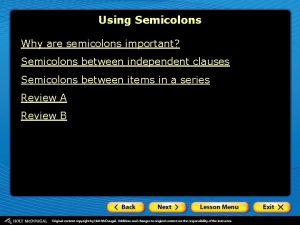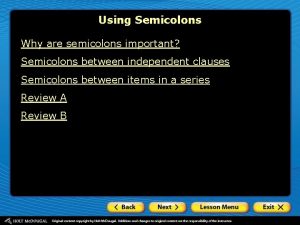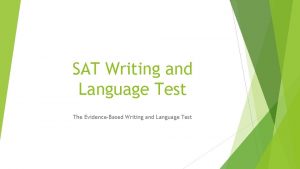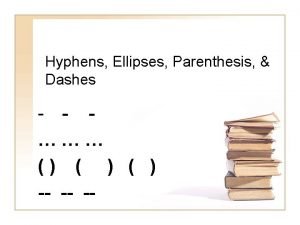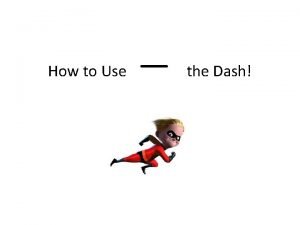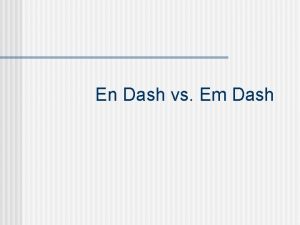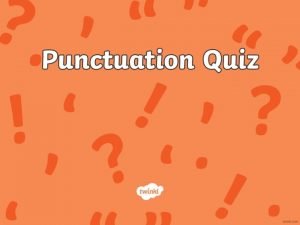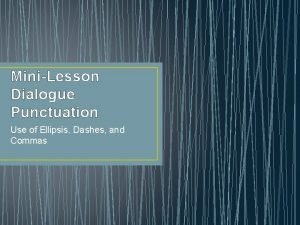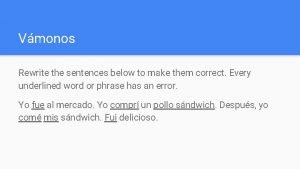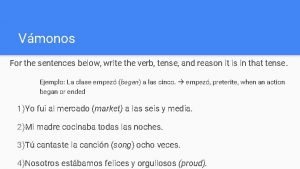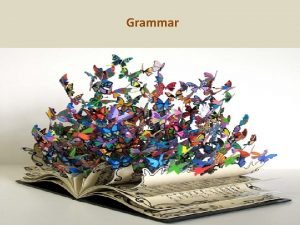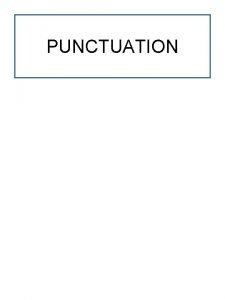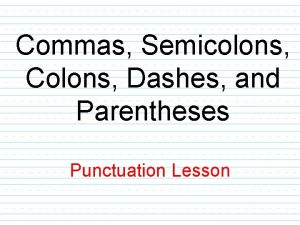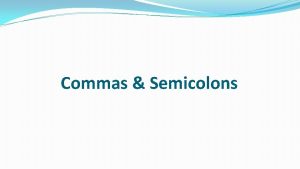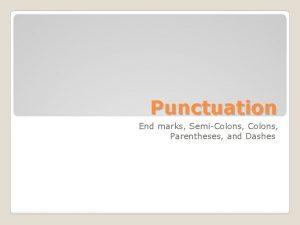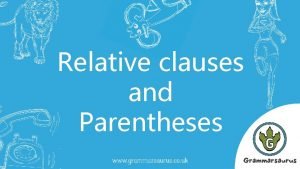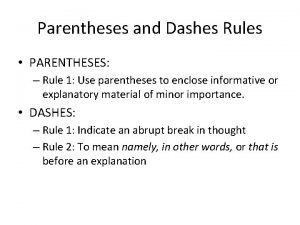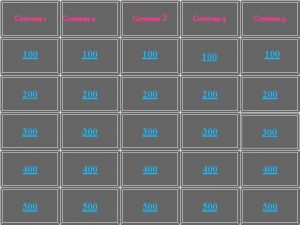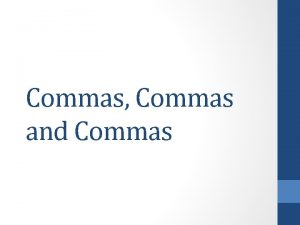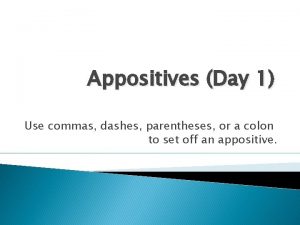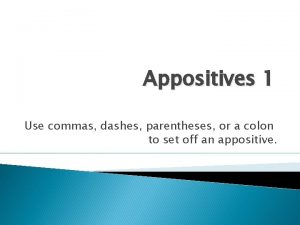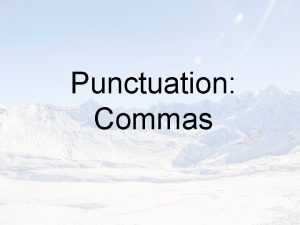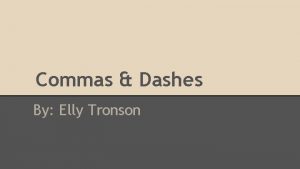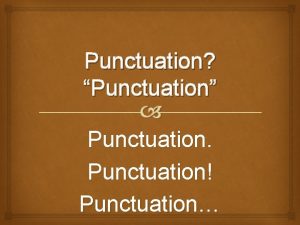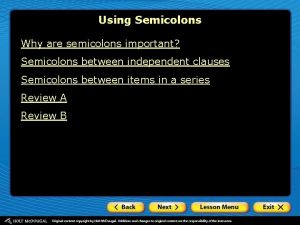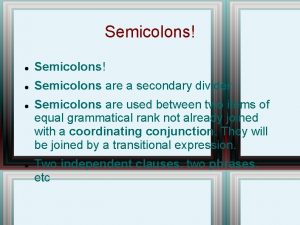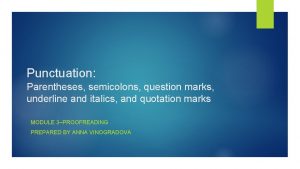PUNCTUATION COMMAS SEMICOLONS DASHES PARENTHESES Sentences with two



























- Slides: 27

PUNCTUATION

COMMAS, SEMICOLONS, DASHES, PARENTHESES Sentences with two main clauses: The bus stopped, but no one got off. (See p. 455. ) The bus stopped; no one got off. (See p. 478. ) The bus stopped; however, no one got off. (See p. 480. ) The mechanic replaced the battery, the distributor cap, and the starter; but still the car would not start. (See p. 482. ) Her duty was clear; she had to locate the problem. (See p. 503. ) Sentences with introductory elements (Modifiers, see p. 457. ): After the argument was over, we laughed at ourselves. Suddenly, the door flew open. (Absolute phrases, see p. 464. ): It’s wing broken, the bird hopped around on the ground. 27. 1 a

COMMAS, SEMICOLONS, DASHES, PARENTHESES (continued) Interrupting and concluding elements: Nonessential elements (See p. 459. ): Jim’s car, which barely runs, has been impounded. Nonessential appositives: Bergen’s only daughter, Candice, became an actress. (See p. 461. ) The residents of three counties—Suffolk, Springfield, and Morrison —were urged to evacuate. (See p. 506. ) Father demanded one promise: that we not lie to him. (See p. 504. ) Essential elements (See p. 461. ): The car, that hit mine, was uninsured We consulted a teacher, who had promised to help us. 27. 1 b

COMMAS, SEMICOLONS, DASHES, PARENTHESES (continued) Interrupting and concluding elements (continued): Essential appositives (See p. 461. ) Shaw’s play, Saint Joan, was performed last year. Transitional or parenthetical expressions We suspect, however, that he will not come. (See p. 461. ) Absolute phrases (See p. 464. ) The bird, its wing broken, hopped about on the ground. Phrases expressing contrast (See p. 464. ) The humidity, not just the heat, gives me headaches. Concluding summaries and explanations We dined on gumbo and jambalaya—a Cajun feast. (See p. 507. ) 27. 1 c

COMMAS, SEMICOLONS, DASHES, PARENTHESES (continued) Items in a series Three or more items Chimpanzees, gorillas, orangutans, and gibbons are all apes. Two or more adjectives before a noun (See p. 465. ) Dingy, smelly clothes decorated their room. Introductory series (See p. 507. ) Appropriateness, accuracy, and necessity —these criteria should govern your selection of words. Concluding series Every word should be appropriate, accurate, and necessary. (See p. 474. ) 27. 1 c

EXERCISE End Punctuation Select choice that correctly punctuates the sentence. Exercise taken from Longman Resources for Instructors: Diagnostic and Editing Tests to accompany Longman 2004 English Handbooks, 6 e 27. 2 a

ANSWERS TO EXERCISE 1. B “Colonialism!” 2. C Colonialism? 3. C power). 4. A Russian? ” 5. B have-nots. ” 6. B effort”? Exercise taken from Longman Resources for Instructors: Diagnostic and Editing Tests to accompany Longman 2004 English Handbooks, 6 e 27. 2 b

PRINCIPAL USES OF THE COMMA To separate main clauses linked by a coordinating conjunction To set off most introductory elements To set off nonessential elements To separate items in a series To separate coordinate adjectives Other uses To set off absolute phrases To set off phrases expressing contrast To separate parts of dates, addresses, long numbers To separate quotations and signal phrases To prevent misreading 28. 1

A TEST FOR ESSENTIAL AND NONESSENTIAL ELEMENTS Identify the element. Hal Nguyen who emigrated from Vietnam lives in Denver. Those who emigrated with him live elsewhere. Remove the element. Does the fundamental meaning of the sentence change? Hal Nguyen lives in Denver. No Those live elsewhere. Yes (Who are Those? ) If no, the element is nonessential and should be set off with punctuation. Hal Nguyen, who emigrated from Vietnam, lives in Denver. If yes, the element is essential and should not be set off with punctuation. Those who emigrated with him live elsewhere. 28. 2

PUNCTUATING TWO OR MORE ADJECTIVES Identify the adjectives. She was a faithful sincere friend. Can the adjectives be reversed without changing meaning? She was a sincere faithful friend. Yes They are medical dedicated students. No Can the word and be inserted between the adjectives without changing meaning? She was a faithful and sincere friend. Yes They are dedicated and medical students. No If yes to both questions, the adjectives are coordinate and should be separated by a comma. If no, the adjectives are not coordinate and should not be separated by a comma. She was a faithful, sincere friend. They are dedicated medical students. 28. 3

PRINCIPAL MISUSES OF THE COMMA Don’t use a comma after a subject or verb. Don’t separate a pair of words, phrases, or subordinate clauses joined by and, or nor. Don’t use a comma after and, but, although, because, or another conjunction. Don’t set off essential elements. Don’t set off a series. Don’t set off an indirect quotation or a single word that is an essential appositive. 28. 4

EXERCISE Revising: Needless or misused commas Revise the following sentences to eliminate needless or misused commas. Circle the number preceding each sentence that is already punctuated correctly. 1. Nearly 32 million US residents, speak a first language other than English. 2. After English the languages most commonly spoken in the United States are, Spanish, French, and German. 3. Almost 75 percent of the people, who speak foreign languages, used the words, “good” or “very good, ” when judging their proficiency in English. 4. Recent immigrants, especially those speaking Spanish, Chinese, and Korean, tended to judge their English more harshly. 5. The states with the highest proportion of foreign language speakers, are New Mexico, and California. 28. 5 a

ANSWERS TO EXERCISE 1. Nearly 32 million US residents speak a first language other than English. 2. After English the languages most commonly spoken in the United States are Spanish, French, and German. 3. Almost 75 percent of the people who speak foreign languages used the words “good” or “very good” when judging their proficiency in English. 4. Sentence correct. 5. The states with the highest proportion of foreign-language speakers are New Mexico and California. 28. 5 b

DISTINGUISHING THE COMMA, THE SEMICOLON, AND THE COLON. The comma chiefly separates both equal and unequal sentence elements. The semicolon chiefly separates equal and balanced sentence elements. Often the first clause creates an expectation, and the second clause fulfills the expectation. The colon chiefly separates unequal sentence elements. 29. 1

USES AND MISUSES OF THE APOSTROPHE Use an apostrophe to form the possessives of nouns and indefinite pronouns. Use an apostrophe to form contractions. The apostrophe is optional for plurals of abbreviations, dates, and words or characters named as words. Do not use an apostrophe plus -s to form the possessives of plural nouns ending in -s. Do not use an apostrophe to form plurals of nouns. Do not use an apostrophe with verbs ending in s. Do not use an apostrophe to form the possessives of personal pronouns. 30. 1

EXERCISE Distinguishing between plurals and possessives Supply the appropriate form—possessive or plural —of each word given in brackets. 1. Demeter may be the oldest of the Greek [god], older than Zeus. 2. Many prehistoric [culture] had earth [goddess] like Demeter. 3. In myth she is the earth mother, which means that the responsibility for the fertility of both [animal] and [plant] is [she]. 4. The [goddess] festival came at harvest time, with [it] celebration of bounty. 5. The [people] [prayer] to Demeter thanked her for grain and other [gift]. 30. 2 a

ANSWERS TO EXERCISE 1. Demeter may be the oldest of the Greek gods, older than Zeus. 2. Many prehistoric cultures had earth goddesses like Demeter. 3. In myth she is the earth mother, which means that the responsibility for the fertility of both animals and plants is hers. 4. The goddess’s festival came at harvest time, with its celebration of bounty. 5. The people’s prayers to Demeter thanked her for grain and other gifts. 30. 2 b

HANDLING QUOTATIONS FROM SPEECH OR WRITING Direct and indirect quotation Direct quotation (See p. 496. ) According to Lewis Thomas, “We are, perhaps uniquely among the earth’s creatures, the worrying animal. We worry away our lives. Quotation within quotation (See p. 497. ) Quoting a phrase by Lewis Thomas, the author adds, “We are ‘the worrying animal. ’” Indirect quotation (See p. 497. ) Lewis Thomas says that human beings are unique among animals in their worrying. Quotation marks with other punctuation marks: Commas and periods (See p. 500. ) Human beings are the “worrying animal, ” says Thomas. Semicolons and colons (See p. 501. ) Machiavelli says that “the majority of men live content”; in contrast, Thomas calls us “the worrying animal. ” 31. 1 a

HANDLING QUOTATIONS FROM SPEECH OR WRITING (continued) Question marks, exclamation points, dashes (See p. 501. ) Part of own sentence: Who said that human beings are “the worrying animal”? Part of the original quotation: “Will you discuss this with me? ” she asked Altering quotations: Brackets for additions (See p. 510. ) “We [human beings] worry away our lives, ” says Thomas. Brackets for altered capitalization (See p. 519. ) “[T]he worrying animal” is what Thomas calls us. He says that “[w]e worry away our lives. ” Ellipsis marks for omissions (See p. 511. ) “We are. . . the worry animal. ” says Thomas. 31. 1 b

HANDLING QUOTATIONS FROM SPEECH OR WRITING (continued) Punctuating signal phrases with quotations: Introductory signal phrase (See p. 468. ) Thomas says that the “worrying animal” is afraid and restless. Concluding signal phrase: We are “the worrying animal, ” says Thomas. Interrupting signal phrase: “I do not like the idea, ” she said; “however, I agree with it. ” 31. 1 c

TITLES TO BE ENCLOSED IN QUOTATION MARKS Songs “Lucy in the Sky with Diamonds” Short poems “Sunday Morning” Articles in periodicals “Comedy and Tragedy Transposed” Short stories “The Battler” Essays “Politics and the English Language” Episodes of television and radio programs “The Mexican Connection” (on 60 Minutes) Subdivisions of books “Voyage to the Houyhnhnms” (Part IV of Gulliver’s Travels) 31. 2

EXERCISE Revising: quotation marks Remove underlining and insert quotation marks where appropriate. 1. In the title essay of her book The Death of the Moth and Other Essays, Virginia Woolf describes the last moments of a frail and diminutive body. 2. An insect’s death may seem insignificant, but the moth is, in Woolf’s words, life, a pure bead. 3. The moth’s struggle against death, indifferent, impersonal, is heroic. 4. Where else but in such a bit of life could one see a protest so superb? 5. At the end Woolf sees the moth lying most decently and uncomplainingly composed; in death it finds dignity. 31. 3 a

ANSWERS TO EXERCISE 1. In the title essay of her book “The Death of the Moth” and Other Essays, Virginia Woolf describes the last moments of a “frail and diminutive body. ” [Underlining correct for book title, but essay title within it is quoted. ] 2. An insect’s death may seem insignificant, but the moth is, in Woolf’s words, “life, a pure bead. ” 3. The moth’s struggle against death, “indifferent, impersonal, ” is heroic. 4. Where else but in such a bit of life could one see a protest so “superb”? 5. At the end Woolf sees the moth lying “most decently and uncomplainingly composed”; in death it finds dignity. 31. 3 b

DISTINGUISHING THE COLON AND THE SEMICOLON The colon is a mark of introduction that separates elements of unequal importance, such as statements and explanations or introductions and quotations. (See p. 503. ) The business school caters to working students: it offers special evening courses in business writing, finance, and management. The semicolon separates elements of equal importance, almost always complete main clauses. (See p. 477. ) Few enrolling students know exactly what they want from the school; most hope generally for a managerial career. 32. 1

DISTINGUISHING DASHES, COMMAS, AND PARENTHESES Dashes give the information the greatest emphasis: (See p. 506. ) Many students—including some employed by the college —disapprove of the new work rules. Commas are less emphatic: (See p. 459. ) Many students, including some employed by the college, disapprove of the new work rules. Parentheses are the least emphatic: (See p. 508. ) Many students (including some employed by the college) disapprove of the new work rules. 32. 2

EXERCISE Other Punctuation Marks Choose the letter that correctly punctuates the sentence. 32. 3 a Exercise taken from Longman Resources for Instructors: Diagnostic and Editing Tests to accompany Longman 2004 English Handbooks, 6 e

ANSWERS TO EXERCISE 1. B (an early 20 th century American astronomers) 2. C Earth: water 3. A[the Mariner missions] 4. B (140 million miles from the sun) 5. Ahistory—one punctuated with warm periods 6. B and/or 32. 3 b Exercise taken from Longman Resources for Instructors: Diagnostic and Editing Tests to accompany Longman 2004 English Handbooks, 6 e
 When to use commas semicolons colons and dashes
When to use commas semicolons colons and dashes Dash ks2
Dash ks2 What is parentheses
What is parentheses Dashes vs parentheses
Dashes vs parentheses Chapter 27 punctuation semicolons answers
Chapter 27 punctuation semicolons answers Semicolon and colon quiz
Semicolon and colon quiz Colon and semicolon rules
Colon and semicolon rules Whats compound sentence
Whats compound sentence Fanboy sentences with commas examples
Fanboy sentences with commas examples Compound sentence starters
Compound sentence starters What is semicolon
What is semicolon Famous quotes with semicolons
Famous quotes with semicolons Comma vs semicolon list
Comma vs semicolon list Semicolon vs colon
Semicolon vs colon Why are semicolons important
Why are semicolons important Famous quotes with semicolons
Famous quotes with semicolons Why are semicolons important
Why are semicolons important When to use dashes sat
When to use dashes sat Dashes hyphens and ellipses
Dashes hyphens and ellipses Em dash
Em dash Em dash use examples
Em dash use examples Alphabet of lines drawing
Alphabet of lines drawing Which sentence is correctly punctuated
Which sentence is correctly punctuated Dashes in dialogue
Dashes in dialogue Rewrite the wrong sentences
Rewrite the wrong sentences Write the sentences below in the past simple.
Write the sentences below in the past simple. Punctuation of compound sentences
Punctuation of compound sentences Identify the underlined words coach macks
Identify the underlined words coach macks
